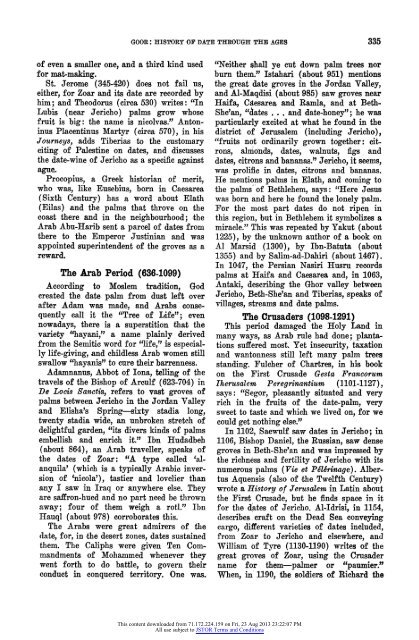The History of the Date through the Ages in the Holy Land
The History of the Date through the Ages in the Holy Land
The History of the Date through the Ages in the Holy Land
Create successful ePaper yourself
Turn your PDF publications into a flip-book with our unique Google optimized e-Paper software.
GOOR: HISTORY OF DATE THROUGH THE AGES 335<br />
<strong>of</strong> even a smaller one, and a third k<strong>in</strong>d used<br />
for mat-mak<strong>in</strong>g.<br />
St. Jerome (345-420) does not fail us,<br />
ei<strong>the</strong>r, for Zoar and its date are recorded by<br />
him; and <strong>The</strong>odorus (circa 530) writes: "In<br />
Lubis (near Jericho) palms grow whose<br />
fruit is big: <strong>the</strong> name is nicolvas." Anton<strong>in</strong>us<br />
Placent<strong>in</strong>us Martyr (circa 570), <strong>in</strong> his<br />
Journeys, adds Tiberias to <strong>the</strong> customary<br />
cit<strong>in</strong>g <strong>of</strong> Palest<strong>in</strong>e on dates, and discusses<br />
<strong>the</strong> date-w<strong>in</strong>e <strong>of</strong> Jericho as a specific aga<strong>in</strong>st<br />
ague,<br />
Procopius, a Greek historian <strong>of</strong> merit,<br />
who was, like Eusebius, born <strong>in</strong> Caesarea<br />
(Sixth Century) has a word about Elath<br />
(Eilas) and <strong>the</strong> palms that throve on <strong>the</strong><br />
coast <strong>the</strong>re and <strong>in</strong> <strong>the</strong> neighbourhood; <strong>the</strong><br />
Arab Abu-Harib sent a parcel <strong>of</strong> dates from<br />
<strong>the</strong>re to <strong>the</strong> Emperor Just<strong>in</strong>ian and was<br />
appo<strong>in</strong>ted super<strong>in</strong>tendent <strong>of</strong> <strong>the</strong> groves as a<br />
reward.<br />
<strong>The</strong> Arab Period (636-1099)<br />
Accord<strong>in</strong>g to Moslem tradition, God<br />
created <strong>the</strong> date palm from dust left over<br />
after Adam was made, and Arabs consequently<br />
call it <strong>the</strong> "Tree <strong>of</strong> Life"; even<br />
nowadays, <strong>the</strong>re is a superstition that <strong>the</strong><br />
variety "hayani," a name pla<strong>in</strong>ly derived<br />
from <strong>the</strong> Semitic word for "life," is especially<br />
life-giv<strong>in</strong>g, and childless Arab women still<br />
swallow "hayanis" to cure <strong>the</strong>ir barrenness.<br />
Adamnanus, Abbot <strong>of</strong> Iona, tell<strong>in</strong>g <strong>of</strong> <strong>the</strong><br />
travels <strong>of</strong> <strong>the</strong> Bishop <strong>of</strong> Arculf (623-704) <strong>in</strong><br />
De Locis Sanctis, refers to vast groves <strong>of</strong><br />
palms between Jericho <strong>in</strong> <strong>the</strong> Jordan Valley<br />
and Elisha's Spr<strong>in</strong>g-sixty stadia long,<br />
twenty stadia wide, an unbroken stretch <strong>of</strong><br />
delightful garden, "its divers k<strong>in</strong>ds <strong>of</strong> palms<br />
embellish and enrich it." Ibn Hudadbeh<br />
(about 864), an Arab traveller, speaks <strong>of</strong><br />
<strong>the</strong> dates <strong>of</strong> Zoar: "A type called 'alanquila'<br />
(which is a typically Arabic <strong>in</strong>version<br />
<strong>of</strong> 'nicola'), tastier and lovelier than<br />
any I saw <strong>in</strong> Iraq or anywhere else. <strong>The</strong>y<br />
are saffron-hued and no part need be thrown<br />
away; four <strong>of</strong> <strong>the</strong>m weigh a rotl." Ibn<br />
fauql (about 978) corroborates this.<br />
<strong>The</strong> Arabs were great admirers <strong>of</strong> <strong>the</strong><br />
date, for, <strong>in</strong> <strong>the</strong> desert zones, dates susta<strong>in</strong>ed<br />
<strong>the</strong>m. <strong>The</strong> Caliphs were given Ten Commandments<br />
<strong>of</strong> Mohammed whenever <strong>the</strong>y<br />
went forth to do battle, to govern <strong>the</strong>ir<br />
conduct <strong>in</strong> conquered territory. One was.<br />
"Nei<strong>the</strong>r shall ye cut down palm trees nor<br />
burn <strong>the</strong>m." Istahari (about 951) mentions<br />
<strong>the</strong> great date groves <strong>in</strong> <strong>the</strong> Jordan Valley,<br />
and Al-Maqdisi (about 985) saw groves near<br />
Haifa, Caesarea and Ramla, and at Beth-<br />
She'an, "aates . . and date-honey"; he was<br />
particularly excited at what he found <strong>in</strong> <strong>the</strong><br />
district <strong>of</strong> Jerusalem (<strong>in</strong>clud<strong>in</strong>g Jericho),<br />
"fruits not ord<strong>in</strong>arily grown toge<strong>the</strong>r: citrons,<br />
almonds, dates, walnuts, figs! and<br />
dates, citrons and bananas." Jericho, it seems,<br />
was prolific <strong>in</strong> dates, citrons and bananas.<br />
He mentions palms <strong>in</strong> Elath, and eom<strong>in</strong>g to<br />
<strong>the</strong> palms <strong>of</strong> Bethlehem, says: "Here Jesus<br />
was born and here he found <strong>the</strong> lonely palm.<br />
For <strong>the</strong> most part dates do not ripen <strong>in</strong><br />
this region, but <strong>in</strong> Bethlehem it symbolizes a<br />
miracle." This was repeated by Yakut (about<br />
1225), by <strong>the</strong> unknown author <strong>of</strong> a book on<br />
Al Marsid (1300), by Ibn-Batuta (about<br />
1355) and by Salim-ad-Dahiri (about 1467).<br />
In 1047, <strong>the</strong> Persian Nasiri Husru records<br />
palms at Haifa and Caesarea and, <strong>in</strong> 1063,<br />
Antaki, describ<strong>in</strong>g <strong>the</strong> Ghor valley between<br />
Jericho, Beth-She'an and Tiberias, speaks <strong>of</strong><br />
villages, streams and date palms.<br />
<strong>The</strong> Crusaders (1098-1291)<br />
This period damaged <strong>the</strong> <strong>Holy</strong> <strong>Land</strong> <strong>in</strong><br />
many ways, as Arab rule had done; plantations<br />
suffered most. Yet <strong>in</strong>security, taxation<br />
and wantonness still left many palm trees<br />
stand<strong>in</strong>g. Fulcher <strong>of</strong> Chartres, <strong>in</strong> his book<br />
on <strong>the</strong> First Crusade Gesta Francorum<br />
Iherusalem, Peregr<strong>in</strong>antium (1101-1127),<br />
says: "Segor, pleasantly situated and very<br />
rich <strong>in</strong> <strong>the</strong> fruits <strong>of</strong> <strong>the</strong> date-palm, very<br />
sweet to taste and which we lived on, for we<br />
could get noth<strong>in</strong>g else."<br />
In 1102, Saewulf saw dates <strong>in</strong> Jericho; <strong>in</strong><br />
1106, Bishop Daniel, <strong>the</strong> Russian, saw dense<br />
groves <strong>in</strong> Beth-She'an and was impressed by<br />
<strong>the</strong> richness and fertility <strong>of</strong> Jericho with its<br />
numerous palms (Vie et Pe'l1r<strong>in</strong>age). Albertus<br />
Aquensis (also <strong>of</strong> <strong>the</strong> Twelfth Century)<br />
wrote a <strong>History</strong> <strong>of</strong> Jerusalem <strong>in</strong> Lat<strong>in</strong> about<br />
<strong>the</strong> First Crusade, but he f<strong>in</strong>ds space <strong>in</strong> it<br />
for <strong>the</strong> dates <strong>of</strong> Jericho. Al-Idrisi, <strong>in</strong> 1154,<br />
describes craft on <strong>the</strong> Dead Sea convey<strong>in</strong>g<br />
cargo, different varieties <strong>of</strong> dates <strong>in</strong>cluded,<br />
from Zoar to Jericho and elsewhere, and<br />
William <strong>of</strong> Tyre (1130-1190) writes <strong>of</strong> <strong>the</strong><br />
great groves <strong>of</strong> Zoar, us<strong>in</strong>g <strong>the</strong> Crusader<br />
name for <strong>the</strong>m-palmer or "paumier."<br />
When, <strong>in</strong> 1190, <strong>the</strong> soldiers <strong>of</strong> Richard <strong>the</strong><br />
This content downloaded from 71.172.224.159 on Fri, 23 Aug 2013 23:22:07 PM<br />
All use subject to JSTOR Terms and Conditions
















